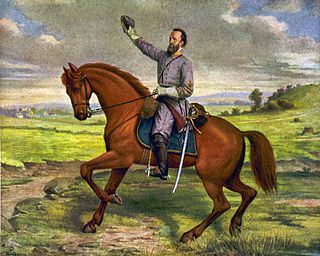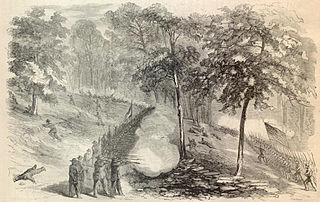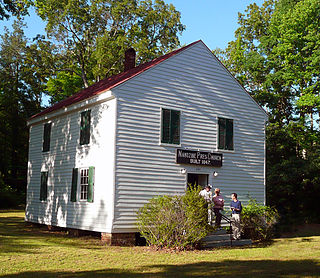
A wargame is a strategy game in which two or more players command opposing armed forces in a realistic simulation of an armed conflict. Wargaming may be played for recreation, to train military officers in the art of strategic thinking, or to study the nature of potential conflicts. Many wargames recreate specific historic battles, and can cover either whole wars, or any campaigns, battles, or lower-level engagements within them. Many simulate land combat, but there are wargames for naval and air combat as well.

The Battle of Lookout Mountain also known as the Battle Above the Clouds was fought November 24, 1863, as part of the Chattanooga Campaign of the American Civil War. Union forces under Maj. Gen. Joseph Hooker assaulted Lookout Mountain, Chattanooga, Tennessee, and defeated Confederate forces commanded by Maj. Gen. Carter L. Stevenson. Lookout Mountain was one engagement in the Chattanooga battles between Maj. Gen. Ulysses S. Grant's Military Division of the Mississippi and the Confederate Army of Tennessee, commanded by Gen. Braxton Bragg. It drove in the Confederate left flank and allowed Hooker's men to assist in the Battle of Missionary Ridge the following day, which routed Bragg's army, lifting the siege of Union forces in Chattanooga, and opening the gateway into the Deep South.

Jackson's Valley campaign, also known as the Shenandoah Valley campaign of 1862, was Confederate Maj. Gen. Thomas J. "Stonewall" Jackson's spring 1862 campaign through the Shenandoah Valley in Virginia during the American Civil War. Employing audacity and rapid, unpredictable movements on interior lines, Jackson's 17,000 men marched 646 miles (1,040 km) in 48 days and won several minor battles as they successfully engaged three Union armies, preventing them from reinforcing the Union offensive against Richmond.

The Battle of South Mountain—known in several early Southern accounts as the Battle of Boonsboro Gap—was fought on September 14, 1862, as part of the Maryland campaign of the American Civil War. Three pitched battles were fought for possession of three South Mountain passes: Crampton's, Turner's, and Fox's Gaps. Maj. Gen. George B. McClellan, commanding the Union Army of the Potomac, needed to pass through these gaps in his pursuit of Confederate General Robert E. Lee's precariously divided Army of Northern Virginia. Although the delay bought at South Mountain would allow him to reunite his army and forestall defeat in detail, Lee considered termination of the Maryland Campaign at nightfall.

The Army of the Cumberland was one of the principal Union armies in the Western Theater during the American Civil War. It was originally known as the Army of the Ohio.

The Battle of Kennesaw Mountain was fought on June 27, 1864, during the Atlanta Campaign of the American Civil War. It was the most significant frontal assault launched by Union Maj. Gen. William T. Sherman against the Confederate Army of Tennessee under Gen. Joseph E. Johnston, ending in a tactical defeat for the Union forces. Strategically, however, the battle failed to deliver the result that the Confederacy desperately needed—namely a halt to Sherman's advance on Atlanta.

The Battle of Williamsburg, also known as the Battle of Fort Magruder, took place on May 5, 1862, in York County, James City County, and Williamsburg, Virginia, as part of the Peninsula Campaign of the American Civil War. It was the first pitched battle of the Peninsula Campaign, in which nearly 41,000 Federals and 32,000 Confederates were engaged, fighting an inconclusive battle that ended with the Confederates continuing their withdrawal.

The Battle of Rich Mountain took place on July 11, 1861, in Randolph County, Virginia as part of the Operations in Western Virginia Campaign during the American Civil War.

The First Battle of Kernstown was fought on March 23, 1862, in Frederick County and Winchester, Virginia, the opening battle of Confederate Maj. Gen. Thomas J. "Stonewall" Jackson's campaign through the Shenandoah Valley during the American Civil War.

The Army of Virginia was organized as a major unit of the Union Army and operated briefly and unsuccessfully in 1862 in the American Civil War. It should not be confused with its principal opponent, the Confederate Army of Northern Virginia, commanded by Robert E. Lee.

The Charles S. Roberts Awards is an annual award for excellence in the historical wargaming hobby. It was named in honor of Charles S. Roberts the "Father of Wargaming" who founded Avalon Hill. The award is informally called a "Charlie" and officially called a "Charles S. Roberts Award". The Wargamer magazine called it "very prestigious". The Award is managed by the Charles S. Roberts Award Committee which has no commercial sponsorship, made up of designers, writers and hobbyists. It is a "people's award" with winners chosen through votes submitted by fans.

The Valley campaigns of 1864 began as operations initiated by Union Lieutenant General Ulysses S. Grant and resulting battles that took place in the Shenandoah Valley of Virginia during the American Civil War from May to October 1864. Some military historians divide this period into three separate campaigns. This article considers them together, as the campaigns interacted and built upon one another.

The northern Virginia campaign, also known as the second Bull Run campaign or second Manassas campaign, was a series of battles fought in Virginia during August and September 1862 in the Eastern Theater of the American Civil War. Confederate General Robert E. Lee followed up his successes of the Seven Days Battles in the Peninsula campaign by moving north toward Washington, D.C., and defeating Maj. Gen. John Pope and his Army of Virginia.

The Maryland campaign occurred September 4–20, 1862, during the American Civil War. Confederate Gen. Robert E. Lee's first invasion of the North was repulsed by the Army of the Potomac under Maj. Gen. George B. McClellan, who moved to intercept Lee and his Army of Northern Virginia and eventually attacked it near Sharpsburg, Maryland. The resulting Battle of Antietam was the bloodiest single-day battle in American history.

The Battle of Namozine Church was an engagement in Amelia County, Virginia, between Union Army and Confederate States Army forces that occurred on April 3, 1865, during the Appomattox Campaign of the American Civil War. The battle was the first engagement between units of General Robert E. Lee's Confederate Army of Northern Virginia after that army's evacuation of Petersburg and Richmond, Virginia, on April 2, 1865, and units of the Union Army under the immediate command of Maj. Gen. Philip Sheridan, who was still acting independently as commander of the Army of the Shenandoah, and under the overall direction of Union General-in-Chief Lt. Gen. Ulysses S. Grant. The forces immediately engaged in the battle were brigades of the cavalry division of Union Brig. Gen. and Brevet Maj. Gen. George Armstrong Custer, especially the brigade of Colonel and Brevet Brig. Gen. William Wells, and the Confederate rear guard cavalry brigades of Brig. Gen. William P. Roberts and Brig. Gen. Rufus Barringer and later in the engagement, Confederate infantry from the division of Maj. Gen. Bushrod Johnson.
The Battle of Crampton's Gap, or Battle of Burkittsville, was a battle fought between forces under Confederate Brig. Gen. Howell Cobb and Union Maj. Gen. William B. Franklin as part of the Battle of South Mountain on September 14, 1862, at Crampton's Gap in Western Maryland, during the Maryland Campaign of the American Civil War.

The western theater of the American Civil War encompassed major military operations in the states of Alabama, Georgia, Florida, Mississippi, North Carolina, Kentucky, South Carolina and Tennessee, as well as Louisiana east of the Mississippi River. Operations on the coasts of these states, except for Mobile Bay, are considered part of the Lower Seaboard Theater. Most other operations east of the Appalachian Mountains are part of the eastern theater. Operations west of the Mississippi River took place in the trans-Mississippi theater.

The eastern theater of the American Civil War consisted of the major military and naval operations in the states of Virginia, West Virginia, Maryland, and Pennsylvania, the District of Columbia, and the coastal fortifications and seaports of North Carolina.

Richard Harvey Berg was a prolific American wargame designer. He was inducted into the Charles Roberts Awards Hall of Fame in 1987.

Tobruk, subtitled "Tank Battles in North Africa 1942", is a board wargame published by Avalon Hill in 1975 that simulates tank combat in North Africa during World War II.

















